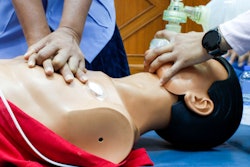
Judged on the composition of today's eagerly awaited professional challenges session, more healthcare professionals are looking to the U.K. for an alternative model for ultrasound services, yet that model is evolving largely due to a shortage of appropriately trained staff.
Most ultrasound examinations in the U.K. are performed and reported by sonographers and radiographers with postgraduate training, unlike in much of mainland Europe and in Australia, Canada, and the U.S., where sonographers tend to perform examinations but rely on an overseeing physician to interpret the examination and write a report.
However, now attention is focusing on the U.K. model due to an escalating need for ultrasound services, said Hazel Edwards, senior sonographer in the department of radiology at East and North Hertfordshire National Health Service (NHS) Trust. This rising demand has resulted from the growing number of elderly patients, the increasing population overall, and the greater incidence of liver and vascular disease often linked to lifestyle choices, she explained.
 The emphasis is on hands-on, interactive training in the ultrasound skills suite at City, University of London. Images courtesy of Gill Harrison.
The emphasis is on hands-on, interactive training in the ultrasound skills suite at City, University of London. Images courtesy of Gill Harrison.At ECR 2017, Edwards plans to outline the three main models of ultrasound scanning in the U.K. She will also discuss the history of the country's sonographer-led model for ultrasound services and give recommendations to support sonographers outside the U.K. who are starting to report examinations.
"We have a service model that works very well in the U.K., but it took a long while to build up," she said, adding that most scans are performed and reported by sonography specialists.
Edwards attributes the U.K.'s reliance on sonographers to several factors, including the financial model of the NHS, which prioritizes safe, reliable, timely, accurate but also affordable care. Furthermore, a shortage of radiologists since the 1970s, combined with the development of increasingly complex radiological procedures, has led to them handing their general ultrasound workload to specially trained radiographers.
Traditionally, sonographers work closely alongside radiologists and are quick to adopt roles that radiologists, for one reason or another, might choose to delegate, she noted. Also, studies show detection rates and accuracy for ultrasound examinations are similar for sonographers and radiologists.
Looking to the future, she believes U.K. sonographers may give up simpler tasks to technicians, while continuing to further develop their own skills. "As for mainland Europe, I anticipate that more sonographer-led ultrasound departments will emerge and independent reporting will become common practice for sonographers," she said.
At the same session, a comparison of the training and education of sonographers between the U.K. and other countries will be covered in a lecture by Gill Harrison, ultrasound program director in the division of midwifery and radiography at City, University of London.
U.K. sonographers complete one to three years of postgraduate training to gain a certificate, diploma, or Master of Science degree in ultrasound. This includes an assessment both of clinical competency in their workplace and report writing.
"The interpretation of ultrasound findings is a crucial part of ultrasound education and is integrated into the curriculum," she said, adding that guidelines from the British Medical Ultrasound Society and the Society and College of Radiographers both recommend that reporting findings is an integral part of the examination.
The ultrasound examination is a dynamic investigation in which the sonographer relies on patient feedback on, for example, the location of pain. The images produced are open to misinterpretation. It seems reasonable that the person doing the scan should also write the report.
The traditional route for supplying the U.K.'s sonographers is training radiographers, but a shortage of sonographers and radiographers means education providers are turning to innovative new models to bring more professionals into the field, Harris said. For instance, the U.K. is starting to offer direct-entry programs that can lead to training placements of students, and students come from a variety of backgrounds. Such programs for training nonhealthcare professionals and extending the role of radiographers already exist in other countries.
Edwards predicts that in the future sonographers will train directly in ultrasound rather than becoming a radiographer or midwife first. "We are living in very exciting times when it comes to U.K. ultrasound education, the likes of which have not been seen in over 20 years," she said.
Finally, Edwards has some advice to sonographers in mainland Europe who are novices at independent reporting: They will need to forge good working relationships with medical colleagues, including radiologists, to discuss results and gain in confidence.
Originally published in ECR Today on 3 March 2017.
Copyright © 2017 European Society of Radiology



















